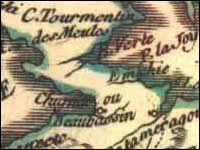


History - Beaubassin (con't)
By 1685, there were 22 houses in Beaubassin, and finally, in 1686, the area was constituted into a parish. It is in this year that a priest, Father Claude Trouvé, of Quebec, built Beaubassin's first church. The parish church was situated exactly where today stands a monument indicating the establishment of Fort Lawrence, built in 1750. Today a railroad crosses that church's cemetery. Beaubassin continued to develop between 1686 and 1714, as young colonists of Port-Royal, the Saint John River, Québec, France, and Acadia established themselves in Beaubassin. On September 25th, 1697 the treaty of Ryswick officially declared that Acadia belonged to France.
| Beaubassin continued to improve with the help of Jacques Bourgeois, who built a flourmill and a sawmill with materials he obtained in Boston. Beaubassin soon began importing a large part of necessary goods for the Acadian population from their English enemies in Massachussetts. When Roger Kuessey, a young Irish refugee |
|
|
who had settled in Port-Royal in 1671, arrived at Beaubassin, he brought with him the first fruit trees. The Acadians could now grow apples, pears and plums, but there was still very little ploughed land in Beaubassin before the deportation. The women made their own muslin, socks, and shoes. Pelts came from fur trading with the natives in the area. Most families possessed between twelve and fifteen sheep, used for wool, while some even had as many as twenty. Every family also had approximately twelve pigs. The Acadians got their necessities from an English ship from Boston, making New England the main supplier to the Acadians. The English accepted furs in exchange for manufactured good, but these transactions put the Acadians so deep in debt, since money was in such great demand, that they had to work for the English in order to re-pay them. Commonly, Acadian men spent their lifetime fishing for the English, only to receive credit at English-owned stores set up in the French villages. This turned Beaubassin into the junction point between the rest of Canada and Acadia since you could arrive by boat from the Gulf of Saint Lawrence. |
|
